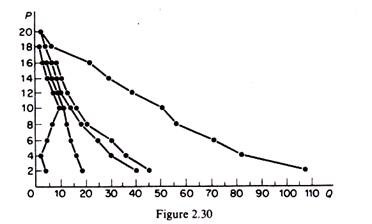A. Derivation of the Market Demand:
The market demand for a given commodity is the horizontal summation of the demands of the individual consumers.
In other words, the quantity demanded in the market at each price is the sum of the individual demands of all consumers at that price.
In table 2.1 we show the demands of four consumers at various prices of a certain commodity and the total market demand.
These data are presented graphically in figure 2.30.
We observe that although for consumer B commodity x is a Giffen good, the market demand has the normal negative slope, because the demands of other consumers more than offset the Giffen case.
Economic theory does not define any particular form of the demand curve. Market demand is sometimes shown in textbooks as a straight line (linear-demand curve) and sometimes as a curve convex to the origin. The linear-demand curve (figure 2.31) may be written in the form
Q = b0 – b1P
ADVERTISEMENTS:
and implies a constant slope, but a changing elasticity at various prices. The most common form of a non-linear-demand curve is the so-called ‘constant-elasticity-demand curve’, which implies constant elasticity at all prices; its mathematical form is
Q = b0Pb1
Where b1 is the constant price elasticity
B. Determinants of Demand:
Demand is a multivariate function;it is determined by many variables. Traditionally the most important determinants of the market demand are considered to be the price of the commodity in question, the prices of other commodities, consumers’ income and tastes. The result of a change in the price of the commodity is shown by a movement from one point to another on the same demand curve, while the effect of changes in other determinants is shown by a shift of the demand curve.
ADVERTISEMENTS:
Thus these factors are called shift factors, and the demand curve is drawn under the ceteris paribus assumption, that the shift factors (prices of other commodities, incomes and tastes) are constant. The distinction between movements along the curve and shifts of the curve is convenient for the graphical presentation of the demand function. Conceptually, however, demand should be thought of as being determined by various factors (is multivariate) and the change in any one of these factors changes the quantity demanded.
Apart from the above determinants, demand is affected by numerous other factors, such as the distribution of income, total population and its composition, wealth, credit availability, stocks and habits. The last two factors allow for the influence of past behaviour on the present, thus rendering demand analysis dynamic.



